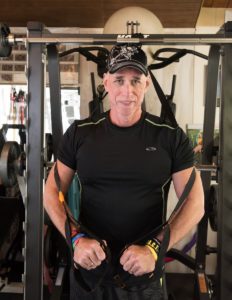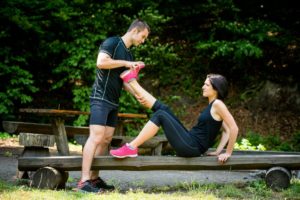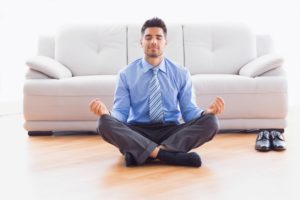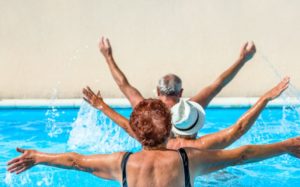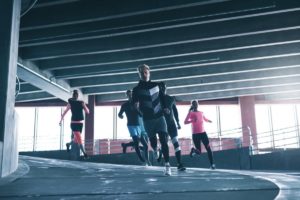Pain/Pain Management
Programming to Prevent ACL Injury
Your new client, 16-year-old Alexis, is a competitive athlete who wants you to design a fitness program that will help her prevent a second anterior cruciate ligament (ACL) tear. She partially tore her ACL while playing soccer and rehabbed it with a physical therapist, who cleared her to play again. Alexis returned to spring softball without an issue, but she would like to be as fully prepared as possible for the upcoming fall soccer season. She hopes to be recruited to play in college, but her parents are concerned she will sustain another ACL injury, perhaps a more severe one.
Exercise’s Impact on Cancer
There are three ways to look at battling cancer. For those who don’t have it, lowering risk is the primary goal. For those who’ve had it, successfully recovering and, of course, reducing the chances of recurrence are of utmost importance. For those who currently have it, the priorities are getting rid of it and minimizing the harmful effects that both the disease and the treatment have on the body. Exercise has been shown to help with all three.
Pillars of Functional Training for Active Aging
Healthy aging is more than the absence of disease, according to the World Health Organization (WHO): “For most older people, the maintenance of functional ability has the highest importance” (WHO 2015). Colin Milner, founder and CEO of the International Council on Active Aging in Vancouver, British Columbia, echoes these comments. “When looking at the healthy aging market today, the focus is all about function,” he says.
The Achilles Tendon
Many fitness professionals have dealt with an Achilles tendon injury, either their own or a client’s. The largest and strongest tendon in the body, the Achilles connects the lower-leg muscles and calf to the heel. “Synchronous functioning” of the tendon and calf is crucial for many activities, including standing on tiptoe, running, jumping and climbing stairs (Bhimji 2016).
Dutch surgeon Philip Verheyen named the tendon (after the Greek hero Achilles) in 1693. Previously, it was known as “tendo magnus of Hippocrates” (van Dijk 2011).
When the Client Is You
client: Frank | personal trainer: Frank McKenna, MEd, owner, Beach Better Bodies | location: Virginia Beach, Virginia
A dire situation. In the summer of 2016, personal trainer Frank McKenna received news he never expected to hear. At age 56, he had recently completed his own physical transformation and was arguably in tiptop shape, so when his doctor told him he had stage 4 lung cancer, he was stunned.
The Anatomy of Functional Training Risks
Many clients can’t seem to get enough of workouts that meld functional movements with high-intensity resistance training. Indeed, workouts using dynamic, high-intensity, full-body movements are great for strength and health—provided the body functions properly and exercisers use correct technique.
Shoulder Pain and Injury Prevention
Shoulder pain and injuries make it harder to exercise and play sports. Damaged shoulders also limit basic functions, impair quality of life and disturb sleep (Acton 2011). What’s more, research suggests that almost a quarter of your client base will experience shoulder pain/injury at one time or another (Ghosh 2012).
How to Handle Exercise-Related Muscle Cramps
You’re running along your favorite path and then it happens: You get a cramp in your hamstring. While theories abound, there is limited consensus on why exercise-associated muscle cramps (EAMC) develop and how to get rid of them. A research review from the Brooks College of Health at the University of North Florida may clear up the confusion.
The review, published in Muscle & Nerve (2016; 54, 177–85), featured a series of studies analyzing the etiology and treatment of EAMC. Here’s what they learned:
Why Proper Rib-Cage Position Is Important
Proper thoracic-cage functioning sets the groundwork for healthy movement.
U.S. Yoga Injuries Increasing
Yoga injuries in the United States are on the rise, particularly among older adults, according to data from hospital emergency rooms nationwide. Researchers from the Center for Injury Sciences at the University of Alabama in Birmingham (UAB), Alabama, examined data from 2001 to 2014 to establish the injury risk involved in yoga participation.
Migraines: A Weighty Issue?
Migraines have long been a malady of unknown etiology, confounding medical practitioners and sufferers alike. A research review suggests that weight may be a factor.
The review included 12 studies and examined records from 288,981 individuals. Analysis showed that people with obesity had a 27% greater chance of developing a migraine than normal-weight people, while underweight individuals were 13% more likely to have a migraine than those of normal weight. Age and gender also correlated with migraine risk.
Treatment Guidelines for Chronic Lower-Back Pain
While some people with lower-back pain may doubt whether movement is the answer, new treatment guidelines from the American College of Physicians (ACP) recommend nondrug therapies as the first line of treatment to relieve acute, subacute and chronic lower-back pain.
Water-Based Weight Loss Programs Help Older Women Manage Knee Problems
Ratcheting up the intensity of water workouts may help women lose weight without exacerbating knee pain, suggests a new study. Knee osteoarthritis (OA) affects around 13% of women aged 60 and older, and the condition can make it painful for them to exercise and lose weight. It can also become a Catch-22, because carrying excess weight can worsen the problem.
Give Yourself a Hand
The next time you pick up a dumbbell and hand it to your client, take a moment to celebrate the hard‐working hand. The hand is an anatomically refined dynamo that's often taken for granted until something as benign as a paper cut shifts the focus distally. Here are some interesting facts to grasp:
The Joy of Movement Rings True
There's nothing like post–knee surgery downtime to catch up on my IDEA Fitness Journal reading. The February 2017 issue is just chock‐a‐block full of delectable goodness. In particular, I enjoyed Ryan Halvorson's article "Embracing the Joy of Movement" and Kelly McGonigal's "Ready to Love Your Stress?" Even after 38 years as a fitness pro, I learn something every issue to help me improve as a group fitness leader and baby boomer specialist. Both articles made their points logically, succinctly and persuasively.
Exercise and Pain Perception in Older Adults
Can physical activity help us modulate pain? 2017 findings from Indiana University—Purdue University Indianapolis suggest that physical activity could offer some relief. The study, published in PAIN (2017; 158 [3], 383—90), aimed to determine if physical activity levels could predict how the nervous system interprets and perceives pain. Fifty–one adults aged 60—77 were recruited to participate. Prior to testing, each wore an accelerometer for 7
days to measure activity levels.
Preventing Golf Injuries
As a golfer, you want to stay injury-free to practice and compete regularly, which ultimately lets you hone your skills and elevate your performance.
To help avoid injury and boost level of play, you need to understand how two key muscle and soft-tissue systems—the posterior oblique system and the anterior oblique system—affect the golf swing.
Does Exercise Benefit Digestive Health?
Gut microbiota has been a hot topic recently, and for good reason, as it is a key indicator of health. Gut microbiota contains trillions of micro-organisms, including at least 1,000 species of known bacteria, with more than 3 million genes (Gut Microbiota for Health 2016). There are many benefits to having a healthy gut, including but not limited to
Can Running Help Inflammation in Knee Joints?
Regular running is often associated with knee problems. However, there’s one condition that researchers now believe may improve with running: inflammation.
Taming Testosterone Troubles
Men: Have you had difficulty getting out of bed in the morning, or are you suffering from low mood or libido? Have you gained body fat, lost muscle or begun to struggle with depression or lack of motivation? Low testosterone levels may be to blame.
- « Previous
- 1
- 2
- 3
- 4
- Next »




